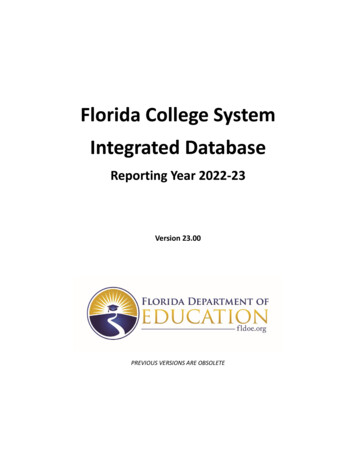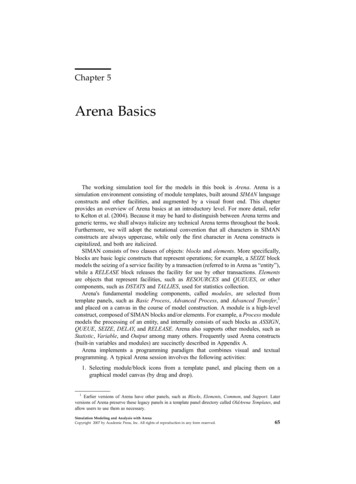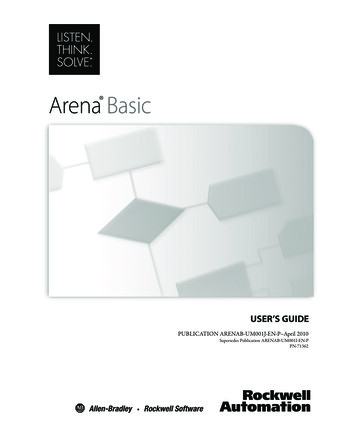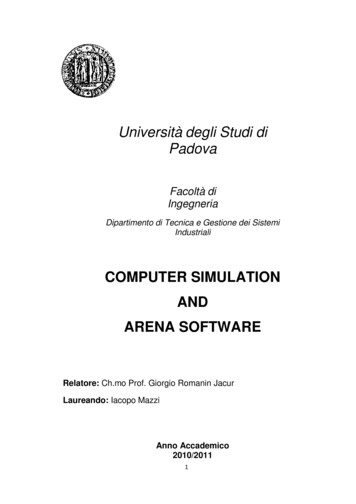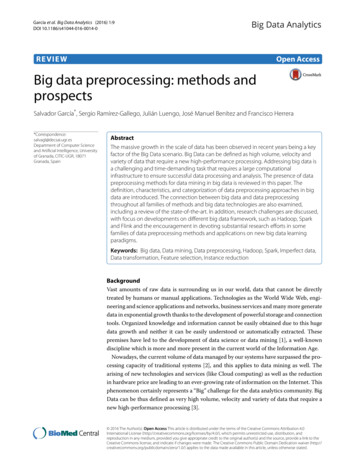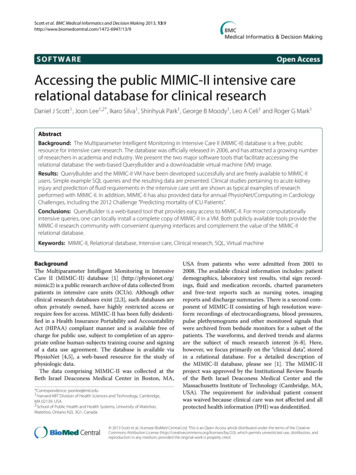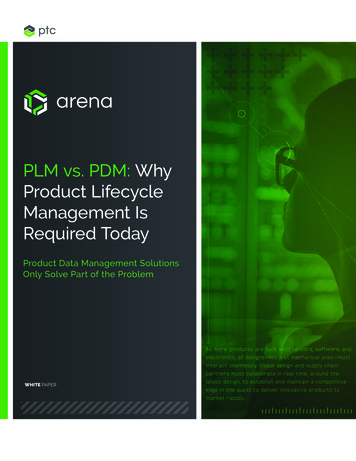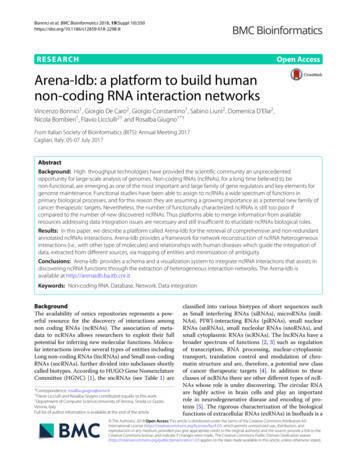
Transcription
Bonnici et al. BMC Bioinformatics 2018, 19(Suppl SEARCHOpen AccessArena-Idb: a platform to build humannon-coding RNA interaction networksVincenzo Bonnici1 , Giorgio De Caro2 , Giorgio Constantino1 , Sabino Liuni2 , Domenica D’Elia2 ,Nicola Bombieri1 , Flavio Licciulli2† and Rosalba Giugno1*†From Italian Society of Bioinformatics (BITS): Annual Meeting 2017Cagliari, Italy. 05-07 July 2017AbstractBackground: High throughput technologies have provided the scientific community an unprecedentedopportunity for large-scale analysis of genomes. Non-coding RNAs (ncRNAs), for a long time believed to benon-functional, are emerging as one of the most important and large family of gene regulators and key elements forgenome maintenance. Functional studies have been able to assign to ncRNAs a wide spectrum of functions inprimary biological processes, and for this reason they are assuming a growing importance as a potential new family ofcancer therapeutic targets. Nevertheless, the number of functionally characterized ncRNAs is still too poor ifcompared to the number of new discovered ncRNAs. Thus platforms able to merge information from availableresources addressing data integration issues are necessary and still insufficient to elucidate ncRNAs biological roles.Results: In this paper, we describe a platform called Arena-Idb for the retrieval of comprehensive and non-redundantannotated ncRNAs interactions. Arena-Idb provides a framework for network reconstruction of ncRNA heterogeneousinteractions (i.e., with other type of molecules) and relationships with human diseases which guide the integration ofdata, extracted from different sources, via mapping of entities and minimization of ambiguity.Conclusions: Arena-Idb provides a schema and a visualization system to integrate ncRNA interactions that assists indiscovering ncRNA functions through the extraction of heterogeneous interaction networks. The Arena-Idb isavailable at http://arenaidb.ba.itb.cnr.itKeywords: Non-coding RNA, Database, Network, Data integrationBackgroundThe availability of omics repositories represents a powerful resource for the discovery of interactions amongnon coding RNAs (ncRNAs). The association of metadata to ncRNAs allows researchers to exploit their fullpotential for inferring new molecular functions. Molecular interactions involve several types of entities includingLong non-coding RNAs (lncRNAs) and Small non-codingRNAs (sncRNAs), further divided into subclasses shortlycalled biotypes. According to HUGO Gene NomenclatureCommittee (HGNC) [1], the sncRNAs (see Table 1) are*Correspondence: rosalba.giugno@univr.it† Flavio Licciulli and Rosalba Giugno contributed equally to this work.1Department of Computer Science,University of Verona, Strada Le Grazie,Verona, ItalyFull list of author information is available at the end of the articleclassified into various biotypes of short sequences suchas Small interfering RNAs (siRNAs), microRNAs (miRNAs), PIWI-interacting RNAs (piRNAs), small nuclearRNAs (snRNAs), small nucleolar RNAs (snoRNAs), andsmall cytoplasmic RNAs (scRNAs). The lncRNAs have abroader spectrum of functions [2, 3] such as regulationof transcription, RNA processing, nuclear-cytoplasmictransport, translation control and modulation of chromatin structure and are, therefore, a potential new classof cancer therapeutic targets [4]. In addition to theseclasses of ncRNAs there are other different types of ncRNAs whose role is under discovering. The circular RNAare highly active in brain cells and play an importantrole in neurodegenerative disease and encoding of proteins [5]. The rigorous characterization of the biologicalfunctions of extracellular RNAs (exRNAs) in biofluids is a The Author(s). 2018 Open Access This article is distributed under the terms of the Creative Commons Attribution 4.0International License (http://creativecommons.org/licenses/by/4.0/), which permits unrestricted use, distribution, andreproduction in any medium, provided you give appropriate credit to the original author(s) and the source, provide a link to theCreative Commons license, and indicate if changes were made. The Creative Commons Public Domain Dedication o/1.0/) applies to the data made available in this article, unless otherwise stated.
Bonnici et al. BMC Bioinformatics 2018, 19(Suppl 10):350Page 26 of 100Table 1 Overview of the major classes of ncRNAs: classification and functional NAs18 24 ntsnoRNAsSmall nucleolar RNAs70 ntsnRNAsSmall nuclear RNAs100 300 ntsiRNAsSmall-interfering RNAs20 25 ntceRNAsCompetitive endogenous RNAs 200 ntThey act as negative control of geneexpression by silencing or catalysingmRNA destabilization.Conserved nuclear RNA in Cajal bodiesor nucleoli where they either function inthe modification of snRNA or participatein the processing of rRNA ribosomesubunit maturation.RNA localized in the eukaryotic cellnucleus. They are part of splicesomemultisubunit complex which assembleson RNA and carriers out RNA splicing.The snRNAs are classified in differenttype according of their role.siRNA derived from much longer doublestranded RNA (dsRNA) precursor byDICER ribonucleases and playa substantial role in genetic andepigenetic regulatory.ceRNAs are transcripts that can crosstalkthrough their ability to compete formRNA binding and they act to sequestermiRNAs.circRNAsCircular RNAs 200 ntpiRNAsPIWI-interacting RNAs25 35 ntlincRNAsLong intergenic non-coding RNAs 200 ntPerform various regulatory roles,but the majority remain functionallyuncharacterized and typically lowabundance and poor evolutionaryconservation.lncRNAsLong non-coding 200 ntlncRNAs are transcripts that lack RNAsapparent protein coding and arelargely heterogeneous and functionallyuncharacterized. The increasingevidence began to suggest that theyplay critical regulatory roles in manuhuman disease.rapidly growing area of research to monitor diseases witha promising use in diagnostic [6].In physiological conditions, many biological entitiesinteract with each another and are key regulators of manycellular processes and contribute to a multitude of diseases [7]. Understanding a biological interactions systemdemands understanding the details of its components, andtheir interactions. Available public biological resourcesprovide narrowed but systematic overviews of relationship schema among biological entities. For example, anindividual miRNA may regulate multiple mRNAs, andin contrast, an individual gene may also be regulatedcircRNAs arise from exons or intronicsand may be also translate into protein.Exonic circRNAs are very stable incell and have specific roles in cellularphysiology.piRNAs show specific expression ingerm cells. Recent studies suggestthat piRNA represents adaptive controlmechanisms that protect genomicsarchitectures again transposableelements (TE). Most piRNA are derivedfrom genomic piRNA clusters.by multiple miRNAs, thus representing a complex network of miRNA-mRNA interactions. More recently, otherlayers of regulation have added further complexity inregulatory networks. It has been proposed that the binding of microRNAs to their targets can be buffered bytranscripts mimicking the sequences of the true targets,therefore protecting them from repression; these transcripts have been called ’competitive endogenous RNAs’(ceRNAs) [8, 9]. If these ceRNAs possess many miRNAs response elements (MREs) and are expressed at highenough levels, they act to sequester miRNAs [10]. Manyexisting databases are unified catalogues of annotations,
Bonnici et al. BMC Bioinformatics 2018, 19(Suppl 10):350sequences and expression information for human ncRNAs [11–19]. These databases are frequently developedonly in the contest of one or few biotypes of ncRNAsand without the integration of diseases associations. Toolssuch as the ones reported in [20–22] provide an integration procedure which does not verify sequence similarityand is mostly focused on genes, proteins and in somecases miRNAs [14]. Moreover, none of these databasesprovide an integrated vision of relationships between different ncRNA biotypes and other entities [23, 24]. In thispaper, we present a computational framework (ArenaIdb) to realize non-coding RNA-Gene regulatory networks. Arena-Idb addresses the gap of existing methodsproviding a framework for network reconstruction ofncRNA heterogeneous interactions (i.e., with other type ofmolecules) and relationships with human diseases whichguides the integration of data extracted from differentsources via mapping of entities and minimization of ambiguity. Arena-Idb handles knowledge regarding biologicalproducts (i.e., information linking transcribed RNA andtranslated proteins to their corresponding source genes,thus from DNA to RNA or protein, and from RNA toprotein) and cross-references (i.e., the mapping betweendifferent nomenclature systems). To keep non-redundantsequences it filters the information by comparing crosslink references and sequence similarity using the Cleanupsoftware [25]. Compared to its previous version [26],Page 27 of 100Arena-Idb provides (i) a mapping procedure for managingentities, (ii) improving the accuracy of the integration process by identifying the sequence entity, (iii) reconstructeddata storage and update including seven new sourcesas Disease Ontology, lnc2cancer, lncACTdb, mir2disease,miRecords, mirSponge, PSMIR, StarBase and TarBase,(iv) a more functional web interface that provides manynew features such as, among others, a browser section thatallows users to visualize, filter and download data by different criteria; a search section that enables queries alsofor chromosomal location; and a network visualizationsystem that also allows the download of data in a readable format for Cytoscape import. The Arena-Idb can beaccessed or downloaded as whole integration system athttp://arenaidb.ba.itb.cnr.it.MethodsThe construction of Arena-Idb is realized through a seriesof sequential steps that go from the collection of datafrom different ncRNA and interaction databases to themining and integration of data for the construction ofheterogeneous interaction networks. An overview of theprocess developed for the integration of input data sourcesis shown in Fig. 1. A initial non-redundant collectionof ncRNAs is built by performing object recognitionvia sequence identity. Interaction sources, that also contain other types of objects, are integrated by cross-linkFig. 1 Arena-Idb integration and content overview. On the left, the “Integration schema” which shows the type of data extracted from each type ofsource used and the processes (sequence identity processing and cross-link identity ) performed for to obtain the data stored and integrated intoArena-Idb (Content schema shown on the figure’s right side). The result of the integration process is a comprehensive database collectinginformation about the objects (genes and their products) and the interactions between ncRNAs and integrated objects
Bonnici et al. BMC Bioinformatics 2018, 19(Suppl 10):350identity recognition. The result of the integration containsinformation about the objects, the interactions betweenncRNAs and integrated objects and biological productsfrom genes to ncRNAs. Figures 2, 3, 4, and 5 give thedetails of the integration process summarized into foursteps. We first describe how data are extracted and represented in Arena-Idb, than we describe each integrationstep sequentially.Data contentThe Arena-Idb data storage is implemented using two different Database Management Systems (DBMS): i) a Relational DBMS, MySQL release 5.5, and ii) a Graph DBMS,neo4J community edition 3.1.3. The MySQL databasestores data about names, annotations and sequences andit is used to efficiently query ncRNAs and to optimizethe retrieval of associated annotations and sequencesinformation. The Graph DBMS efficiently handles theconstruction and visualization of the networks of thousands of biological entities (nodes) and relations (edges).We use the relation part of the data storage also toPage 28 of 100facilitate the integration in Arena-Idb of new data sources(often released as relational DBMSs). We developed specific procedures in Cypher Query Language for the dataporting from relational DBMS to Neo4J which automatically ingest relationships and graph information aboutalias, multi-resources referencing and biological entitiesinteractions.Table 2 reports the data sources integrated in ArenaIdb together with further information such as the typeof extracted biological entities. To gather data fromall sources we implemented customized Extract, Transformation and Load (ETL) procedures for data available in different forms: TSV (Tab-separated values),CSV (Comma- separated values), and Biomart/Ensemblinstances that are queried and processed by REST API, Rprocedures and Pentaho Data Integration (Kettle) ation).Sequence data in Arena-Idb are loaded by using RESTBiomart API calls for VEGA/HAVANA and ENSEMBLncRNAs, by parsing the Genbank entries files (GBFF flatfiles) downloaded from NCBI FTP using BioJava API calls,Fig. 2 Arena-Idb integration process: identity by sequences. The Figure gives an example of integration performed by sequence identityrecognition. Two miRNAs, identified by miRBase symbols, are integrated into a partial state of Arena-Idb that contains two ncRNA, identified by theirEnsembl IDs. The sequences of one of the two miRBase miRNAs is recognized in the partial state thus the miRBase symbol is added up to the list ofaliases assigned to the miRNA object. Instead, no compatible sequences are found for the other miRBase miRNA. The results of the integration is acollection of three ncRNAs
Bonnici et al. BMC Bioinformatics 2018, 19(Suppl 10):350Page 29 of 100Fig. 3 Arena-Idb integration process: identity by aliases, example 1. The Figure gives an example of integration regarding the addition of a ncRNAand a gene into a partial state of Arena-Idb that contains a ncRNA. The input ncRNA is labelled with a HGNC symbol that equals the identifierassigned to the ncRNA present in the partial state. Instead, there is no identifier that can match the gene symbol. The input information also report abiological production of the ncRNA from the given gene. The gene is added to the partial knowledge, the two ncRNAs are matched, and thebiological relation is flushedFig. 4 Arena-Idb integration process: indetity by aliases, example 2 The Figure gives an example of integration that does not add any new object tothe current knowledge, instead it extends the set of aliases linked with the existing object. The input ncRNA has no assigned sequence, thus arecognition by sequences is not available. The HGNC symbol is used to recognize the identity of the two ncRNAs, and the miRBase identifier isadded to the list of the aliases linked with the ncRNA
Bonnici et al. BMC Bioinformatics 2018, 19(Suppl 10):350Page 30 of 100Fig. 5 Arena-Idb integration process: identity by aliases, example 3 The Figure reports an example of integration of a ncRNA and a protein into apartial state of Arena-Idb. The ncRNA is labelled with two identifiers, a symbol and an Ensembl ID, and the protein is labelled only with a symbol. Ainteraction between the two objects is reported. In this case, two ncRNAs are already present in the partial knowledge. They are alternativetranscripts of the HOTAIR gene, thus they are labelled with the symbol HOTAIR. However, the two ncRNAs can be distinguished by the specificEnsembl identifier linked with them. The integration procedure recognizes the identity of the input ncRNA with one of the two already present inthe partial state by means of the Ensembl identifier. On the contrary, the input protein is directly mapped to a protein already in the partial statesince no alias ambiguity arises. Finally, the biological interaction is flushed to the final knowledge baseand by parsing downloadable fasta formatted files frommirBase, GtRNAdb, and pirnaBank. Tables 3 and 4 reportthe total amount of entities and interactions, respectively,that result in Arena-Idb at the end of the integrationprocess.Arena-Idb stores biological entities according to theirbiological classes (gene, pseudogene, pcRNA, ncRNA,protein, phenotype, other) and biotype. A biotype is a consensus classification of entities by their physical or functional characteristics, for example the distinction betweenlong non-coding RNAs and microRNAs or circulatingRNAs d transcript types.html).Biological entities are often reported in multiplesources. Some of them define an internal nomenclaturesystem, called also namespace, and assign new identifiersto entities. Some others use existing identifiers assigned inexternal namespaces. We refer to those identifiers as RIDs(Reference-ID). More precisely, a RID is a pair of strings,the first one refers to the reference namespace, and thesecond string reports the identifier within the namespace(for example HGNC:29665). Most reference sources also
Bonnici et al. BMC Bioinformatics 2018, 19(Suppl 10):350Page 31 of 100Table 2 List of the database resources with related information extracted and used in Arena-Idb platform. Legend: BI BasicInformation; S Sequences; CR Cross references;); ncRNAs (non-coding RNA); pcRNAs (protein coding RNA); G Gene; Ps Pseudogene;D Disease; P Protein, GO Ontology, I Interactions (NN:ncRNA-ncRNA, NM:ncRNA-pcRNA, NG:ncRNA-Gene, NS:ncRNA-Pseudogene,ND:ncRNA-Disease, NO:ncRNA-Others)DatabaseBiological Entities extractedAnnotated InformationDescriptionHGNC [1]ncRNA, pcRNA, G, DBI, CRA curated collection of approved HumanGene NomenclatureGenecode [39]ncRNA, pcRNA, G, PSBI, SReference gene annotation and experimental validation for human and mouse.VEGA/Havana [40]ncRNABI, SA repository for gene model produced bythe manual annotation.Ensembl [41]ncRNABI, S, CRGenome browser database for vertebratewith annotate gene.miRBase[42]ncRNABI, SDatabase of of published miRNA sequencesand annotation.RefSeq [43]ncRNABI, SCollection of integrated, non-redundant andwell annotated set of transcript and genomicdata.GtRNAdb [44]ncRNABI, SGenomic tRNA database.piRNAbank [45]ncRNABI, SResource on classified and clustered piRNAs.Disease Ontology [46]D, GOCRDatabase of standardized ontology ofhuman disease.Circ2Traits [47]ncRNA, pcRNA, G, DNN, NM, NG, NDA comprehensive database of humancircRNAs associated with diseases and traits.HMDD [48]ncRNA, G, DNG, NDA collection of experimentally supportedhuman miRNAs and disease associations.Lnc2Cancer [49]ncRNA, DCR, NDA manually curated database ofexperimentally lncRNAs associated withcancer.LncActDB [50]ncRNA, DNN, NG, NDDatabase containing a list of lncRNA andmRNA with regulatory roles.LncRNAdb [51]ncRNA, G, PNN, NG, NPA database of functional lncRNAs.LncRNADisease [52]ncRNA, DNP, NDA curated DB of lncRNA with diseases.Mir2diseases [53]ncRNA, G, DNG, NDA manually curated database for miRNAderegulation in human diseases.MiRandola [6]ncRNA, DNDCollection of extracellular circulating miRNAsand their deregulation in human disease.miRecords [54]ncRNA, GNGA collection of validate miRNA targetinteraction with the exclusion of predictedinteractions.miRTarBase [55]ncRNA, GNGA database of experimentally validate miRNAtarget interactions.mirSponge [56]ncRNA, pcRNA, G, Ps, DNN, NM, NG, NP, NDManually curated database of miRNAspanges and ceRNAs.NONCODE [57]ncRNACRA database of ncRNA with integrated onlythe Cross-References.NPInter [18]ncRNA, PNN, NPDatabase of experimentally verifiedinteraction between ncRNA and otherbiomolecules.PSMIR [58]ncRNANOA database of potential associationsbetween small molecules and miRNAs.StarBase [59]ncRNA, G, P, PsNN, NG, NS, NPA database of miRNA-mRNA interactions.TarBase [60]ncRNA, GeneNGA database of curated experimentallyvalidate miRNA targets.
Bonnici et al. BMC Bioinformatics 2018, 19(Suppl 10):350Page 32 of 100Table 3 List of the number of biotypes with alias present inArena-Idb and the number of their interactionsName of gene16.754Protein2.019Disease844Other-Small molecule1.309provide mappings between internal and external RIDs,such mappings are called cross-references.In Arena-Idb, RIDs are stored apart from entities, andmay be linked to multiple entities, possibly with differententity classes. Interactions are stored as tuples containing the internal identifiers of the interacting biologicalentities, the names and versions of the original datasources, the tools predicting the interactions (if they arenot validated), and the PubmedIDs of the scientific articlesreporting them together with supporting sentences fromthe bibliography.Identity by sequence: detection of redundant non-codingRNAs by sequence similarityThe first step of the Arena-Idb pipeline integrates sourcesof non-coding RNA sequences into a non-redundant collection of ncRNA objects. The task is performed by usingthe Cleanup tool [25], a fast program for removing redundancies from nucleotide sequence databases. Sequenceshaving high grade of identity and overlap, in the samebiological biotype, are purged.Figure 2 shows an input resource providing two ncNRAswith associated sequences s1 and s2 . The partial collectionalready contains the ncRNAs having sequences s1 and s3 .The integration tool recognizes the two ncRNAs havingsequences s1 as the same object, and produces an updatednon-redundant collection composed by s1 , s2 , and s3 . Thecollection of data obtained by merging all the sequenceTable 4 Number of interactions between different biologicalclasses in the Arena-Idb platformInteractions typesources is used as base in Arena-Idb for the successiveintegration ity by alias: detection of redundant entities by RIDscomparisonsRIDs in a namespace are designed to be specific of agiven object, and cross-references are supposed to helpin mapping entities between different namespaces. However, cross-references do not map every namespace toanother, and they may introduce inconsistency and ambiguity. As a result, biological entities may share one orseveral identifiers, making the task of recognizing themas distinct objects a bottleneck on the integration process.In addition, input source may have a lack of information. Mining procedures in Arena-Idb allow deducingmissing data. For example, for entities without reportedbiological classes, Arena-Idb finds out their classes bysearching for entities with a similar set of linked RIDs.Arena-Idb follows an order of resource integration corresponding to the amount of information provided by eachsource (miRTarBase, HMDD, miR2Disease, miRecords,miRandola, circ2Traits, NPInter, miRSponge, starBase,lncACTdb, Psmir, TarBase, Lnc2Cancer, LncRNADisease, lncRNAdb).The integration procedures are performed by comparing the sets of RIDs associated with them. For every inputentity, if the current collection contains an entity with acomparable set of RIDs, then the input entity is matchedto it, otherwise the entity is added up to the collection.Figure 3 shows two input RIDs having the same labelthat is microRNA 144 but associated with objects of different class, a ncRNA and a gene. In the current state ofArena-Idb the RID related to microRNA 144 is mapped toa ncRNA. Therefore, the input ncRNA and the one alreadyin Arena-Idb are recognized as the same object. On thecontrary, the input gene does not have a correspondencein Arena-Idb, thus it is added to it, together with its linkedRID. Entities of different classes but having same RIDs arereal examples of transcripts named with the same labelused for their producer genes. Figure 4 shows the importof a cross-reference linking two RIDs, microRNA 144 andhsa-mir-144, that are referred to the same ncRNA object.The current state of Arena-Idb already contains a ncRNAobject labelled with microRNA 144 but missing of thehsa-mir-144 RID. The identity by aliases approach implemented by Arena-Idb recognizes the equivalence of thetwo objects, since they have the same label microRNA 144in common, and the integration procedure updates, withthe additional RID hsa-mir-144, the information linked tothe ncRNA.Figure 5 reports a real example of transcripts sharingone or more RIDs, possibly because they are isoformsof the same gene. The input source contains a ncRNAwith two RIDs: HOTAIR and ENST00000424518. The
Bonnici et al. BMC Bioinformatics 2018, 19(Suppl 10):350procedure maps the input entity with the ncRNA having acomplete match with the set of aliases of the input ncRNA,while the ncRNA associated to ENST00000453875 partially overlap the set. Figure 5 gives also an example ofcross-references. Once entities of an input source aremapped to those already contained in the database, theinformation regarding interactions and additional crossreferences is added to Arena-Idb. As a result, the step unifies the plenty of integrated sources and provides a highercomprehensive view of the currently known informationregarding interactions in which ncRNAs are involved.Finally, during the integration, customized proceduresregarding miRNAs and disease names are applied. ArenaIdb adds, to the miRNA entities, additional RIDs thatrefers to miRNA genes (see http://www.mirbase.org/help/nomenclature.shtml). Regarding phenotype entities, inpresence of RIDs containing parenthesis, names are splitinto two or more identifiers. Arena-Idb also defines a setof regular expressions to express all extracted RIDs identifiers (e.g., HGNC:[0-9] refers to HGNC IDs). Since RIDsmay lack of reference source names, the integration procedure approximately matches the incomplete RID againsta set of regular expressions in order to assign the correctnamespace.Detection of primary namesA final step of integration is performed to assign a single representative RID, called primary name, to everybiological entity. The algorithm extracts subsets of entities belonging to the same biological class and sharingat least one RID. In order to choose the primary names,the algorithm takes into account two properties regarding RIDs. First, it defines the following order of trustinessresources: miRBase, VEGA, RefSeq, Ensembl, GtRNAdb,piRNABank, snoRNABase, Entrez, and all the other notlisted resources have the same preference order. Second,it counts the number of entities that are linked to a givenRID. Identifiers with fewer entities are preferred. Thedescribed combinatorial approach is hard to solve causeevery possible combination of RIDs to entities must bescanned. Since, similar combinatorial problems are wellknown in literature, such as the “stable marriage problem”,we represent entities and RIDs in a bipartite network andapply heuristics to reduce the computational time neededto find a solution for the mapping. Briefly, entities withthe fewest number of RIDs linked to them are accountedfirstly, and the sets of their RIDs are sorted by the aboveprecedence’s list.Data updateData update is performed by re-running globally or partially the ETL procedures. More precisely, we can summarize the database population procedure into two mainsteps. In the first step, semi-automatic ETL proceduresPage 33 of 100(tailored to each input sources) gather data from external primary sources, producing a homogeneous representation of input resources and merge it into a singleknowledge base. In the second step, the external interaction sources are parsed and all the interactions among themates are built. Therefore, a main update of Arena-Idbinvolves the execution of all the ETL procedures to buildthe database from scratch. However, updating a singleexternal source only consist of the execution of the scriptsrelated to that source in the first and second phase. Furthermore, the normalization performed by the first ETLphase allows to add new external resources to the systemwithout substantial modification of the overall procedure,the database maintainer can execute only the ETL scriptrelated to the new source using the developed ETL astemplate.ResultsThe Arena-Idb provides an easy-to-use graphical webinterface and graphical visualization to facilitate theretrieval of ncRNAs interactions. The Graphical UserInterface (GUI) has been developed as JAVA Web Application in Java Platform Enterprise Edition - Java EE.It uses jQuery/jQuery-UI framework JavaScript on theclient layer, Java servlets and JavaServer Pages (jsp) on theserver layer. The web application is deployed in a Tomcat web server (https://tomcat.apache.org). The HibernateORM (Object Relational Mapping, http://hibernate.org/orm/) has been adopted to implement the communication between the data layer (MySQL and Neo4j) and theWeb Application. It also provides a framework for mapping an object-oriented domain model to relational andgraph databases enabling us to handle the data layer asobjects in the web pages.Arena-Idb provides two modes to access to data, Searchand Browser. Browser lists in a tabular mode all pairs ofinteracting entities in Arena-Idb reporting their tuples ofinformation (as described in Data content section). Usercan browse by RNA-RNA, RNA-gene, RNA-Protein, andRNA-Disease interaction.The Search mode allows to retrieve ncRNAs using thefollowing criteria: by ncRNA/gene name, by genomiccoordinates, and by disease name (see Fig. 6). When onestarts typing ncRNA/gene name or disease name into thesearch box, suggested ncRNA/gene or disease names aredisplayed in the list box. The end user chooses one of thenames associated to the biological entity from the list box.In order to use the search by genomic coordinates the userchooses the number of the chromosome and the startingand ending positions of
Bonnicietal.BMCBioinformatics2018,19(Suppl10):350 Page27of100 sequences and expression information for human d .

